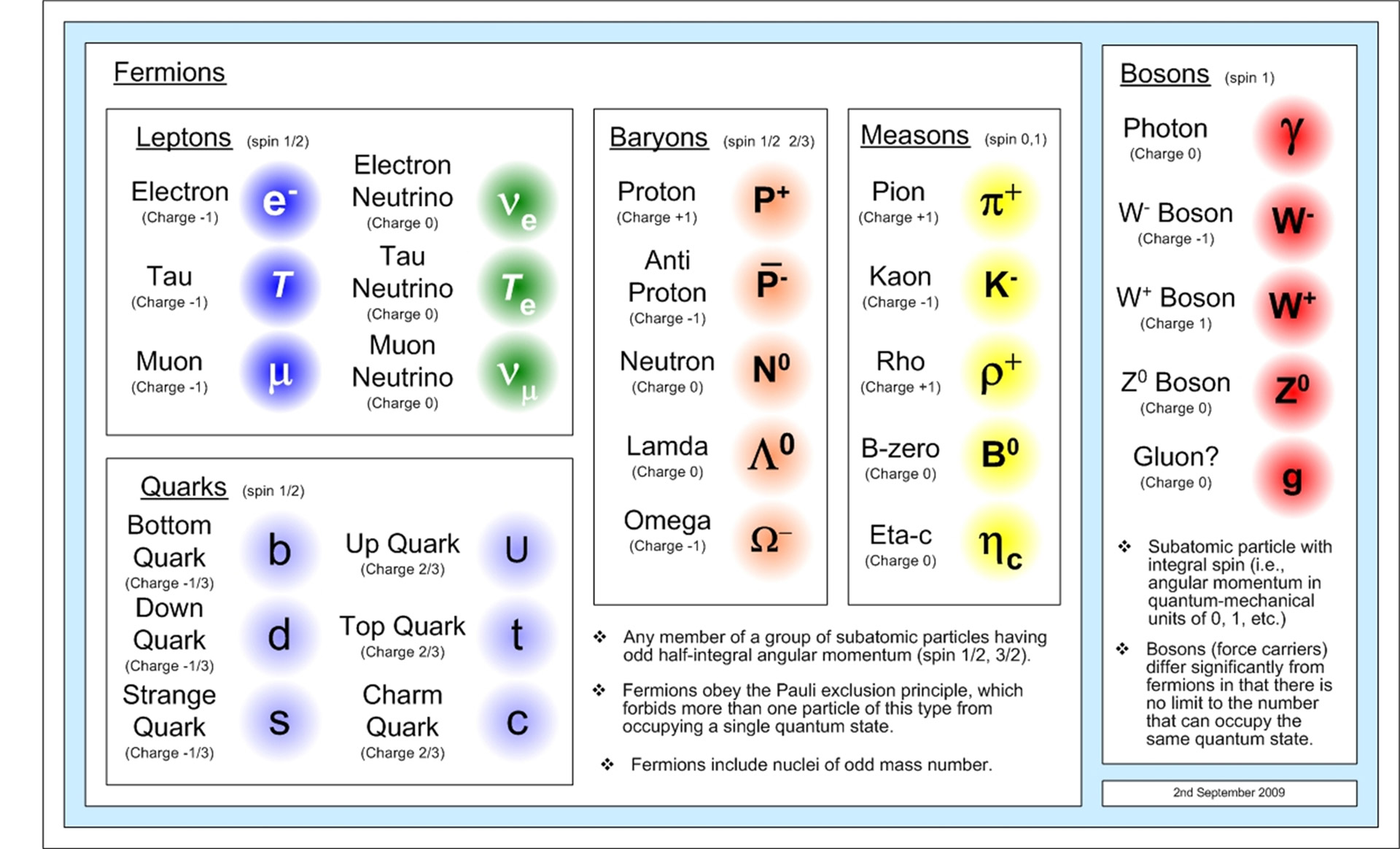Standard Model
The Standard Model is a system of classification of all known elementary subatomic particles. The particles are classified in terms of spin and electric charge. The model also describes the strong nuclear force, electromagnetic force, and weak nuclear force. While the gravitational force is currently left out, its inclusion would elevate the Standard Model to the status of the Grand Unified Theory.

Elementary particles
In the Standard Model, all matter is composed of the elementary particles and their antiparticles, which have both the same mass and same spin but opposite charge, lepton number, and baryon number.
Quarks are fermions that bind together via the strong force to form hadrons. Each quark can come in one of three different colors: red, blue, or green.
Name Charge Spin Generation Up \(\frac23\) \(\frac12\) \(1^{st}\) Down \(-\frac13\) \(\frac12\) \(1^{st}\) Top \(\frac23\) \(\frac12\) \(2^{nd}\) Bottom \(-\frac13\) \(\frac12\) \(2^{nd}\) Charm \(\frac23\) \(\frac12\) \(3^{rd}\) Strange \(-\frac13\) \(\frac12\) \(3^{rd}\)
Which of these particles has charge \(+\dfrac13?\)
Leptons are fermions that do not participate in the strong force. They can be either charged (electron-like) or uncharged (neutrinos). In any interaction, the lepton number (\(L\)) must be conserved. Each "normal" lepton has \(L=1\) while each antiparticle has \(L=-1.\) Every other particle has \(L=0.\)
Name Charge Spin Electron (\(e\) or \(e^-\)) \(-1\) \(\frac12\) Muon (\(\mu\)) \(-1\) \(\frac12\) Tau (\(\tau\)) \(-1\) \(\frac12\) Electron neutrino (\(v_e\)) \(0\) \(\frac12\) Muon neutrino (\(v_{\mu}\)) \(0\) \(\frac12\) Tau neutrino (\(v_{\tau}\)) \(0\) \(\frac12\)
Gauge bosons are massless bosons that serve as mediators for the fundamental forces.
Name Charge Spin Force mediated Gluon (\(g\)) \(0\) \(1\) Strong Photon (\(\gamma\)) \(0\) \(1\) Electromagnetic \(Z\) \(0\) \(1\) Weak \(W\) \(\pm 1\) \(1\) Weak (Hypothetical\(\dagger\)) graviton \(0\) \(2\) Gravity \(\dagger\) The graviton is hypothetical because it both has not been observed and also suffers from incompatibility with quantum effects at high energies. These problems are proposed to be alleviated by string theories, but this is still currently being debated.
The Higgs boson is an elementary particle which is a quantum excitation of the Higgs field. Since it has no spin, it is said to be a scalar particle. It is the only currently known scalar particle.
Name Charge Spin Higgs boson (\(H\)) \(0\) \(0\)
Which of these is a spin-\(\frac12\) particle that does not participate in the strong force?
Composite particles (hadrons)

Hadrons are composite particles made up of quarks. A hadron composed of 3 quarks is a baryon and classified as a fermion (spin-\(\frac12\)), while a hadron composed of a quark and an antiquark is a meson and classified as a boson (integer spin).
A proton is composed of two up quarks and one down quark. What is the charge of a proton?
Each up quark contributes \(\frac23\) while the down quark contributes \(-\frac13.\)
\[q = \frac23 + \frac23 - \frac13 = 1\]
As expected, the proton has charge \(+1.\)